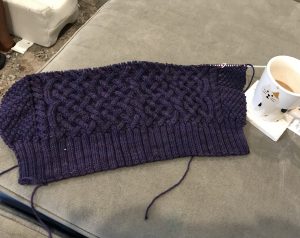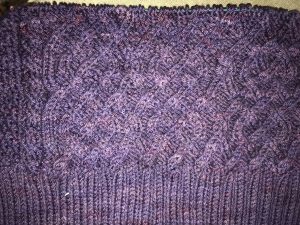
Morning cable knitting–coffee required!
Are you a knitter who has always admired cabled Aran sweaters, but think they look too complicated to give it a go yourself? Fear not, my friends: cabled knitting is a lot easier than you think! And, what’s more, it’s easy to do if you already know how to knit and purl, and it looks super complicated, so you’re sure to impress!
What are you doing when you’re cabling? Essentially, you’re moving stitches around by taking them off and putting them on a cable needle, and then putting them back on your main needle. The cables are sets of knitted stitches that are set off by surrounding them with purl stitches: so you’re looking at stockinette stitch on a background of reverse stockinette. Usually, the cables only appear on the right side of your knitting; on the reverse side, you just knit the knit stitches and purl the purls–so every other row, you don’t need to look at the pattern! (I love that–that way I can watch reruns of Gilmore Girls or Grey’s Anatomy or the latest Mock the Week while knitting.)
Note about cable needles: There are lots of styles, but I think the easiest thing to do is to use a regular double-pointed needle that’s one or two sizes smaller than the knitting needles you’re using (so, if you’re knitting on size 8, use a size 6 double point). You can try a cable needle if you want, too–as you try different methods, you’ll find what’s easiest for you. I had a friend back in Chicago who mostly worked cables without any cable needle, which you can do if the cables are small (if you have a 5X5 cable, you’ll need to use a cable needle).
The picture above, and the one below, are of the sweater I’m currently working on. There are tons of books of Irish-knit patterns. This one is from an excellent collection called Woodsmoke: Cable Collection. Some of my other favorites include:
Cabled knitting requires a yarn that is either solid or only slightly variegated. The yarn should also have good stitch definition (so, don’t use angora or anything fuzzy like mohair). And lighter colors show the cabled pattern better than dark colors. My favorite yarn for cabling, and the one I’m using on this sweater, is Mrs. Crosby’s Steamer Trunk. It’s heavy, has great stitch definition, and you can usually buy enough skeins of a single dye-lot to make a sweater.

A close-up of my current project. There are so many cables here that this sweater is slow-going–but it will be worth it!
For beginners to cabling, I strongly recommend starting with a scarf. Scarves are straight all the way from beginning to end, so you just need to focus on the techniques of cabling, rather than worrying about increases and decreases, or shaping a neckline. Look on Ravelry.com for easy cabled patterns.
And, lastly, one of the most important factors to making your Irish cabled patterns pop: YOU MUST BLOCK YOUR WORK. This point cannot be overemphasized. If you don’t know how to block, or you have cats that seriously impede the blocking process, many yarn stores will block work for you (for a small fee).
]]>